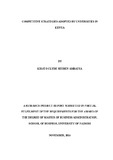| dc.description.abstract | In a competitive industry, there exist various players pitied against each other in a game
that is, seeking competitive advantage. The higher education industry in Kenya in not any
different, the various players are in the form of the individual, with each seeking to make
critical decisions on which competitive strategy to adopt that will guarantee better payoffs.
The objectives of the study were to determine the forces that define competition in the
higher education sector, and to determine the competitive strategies adopted by universities
in Kenya, established between the years 2012 to 2015. The study was underpinned on the
game theory and the strategic conflicts theory. A cross-sectional census survey study was
carried out on universities established between the years 2012 and 2015. Primary data was
collected by administering structured questionnaires to the top management of the
institutions by mail. The data was analyzed using descriptive and inferential statistics. The
findings of the study were found to be consistent with existing theory on the forces that
define competition. Industry factors were found to affect the universities under study to a
higher extent than macro environment forces. Further, the generic strategies were found to
be adopted to a higher extent than the grand strategies. Differentiation and integration were
found to be the most adopted strategies from the two groups of strategies. It was concluded
that the strategies adopted were largely generic strategies and that the forces that define
competition were largely industry forces. It was recommended that universities analyze
their environments both internal and external and forecast changes to enable choice of the
best strategy. Limitations to the study included the generalization of the findings for public
and private universities, and limitation of the cross sectional survey over longer periods of
time. The researcher proposed further studies in the areas of limitation of the study. | en_US |



